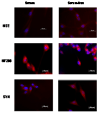Neuroprotective effects of neuregulin-1 on B35 neuronal cells following ischemia
- PMID: 18410912
- PMCID: PMC2442468
- DOI: 10.1016/j.brainres.2008.02.059
Neuroprotective effects of neuregulin-1 on B35 neuronal cells following ischemia
Abstract
We previously showed that neuregulin-1 (NRG-1) protected neurons from death in vivo following focal ischemia. The goal of this study was to develop an in vitro rat ischemia model to examine the cellular and molecular mechanisms involved in the neuroprotective effects of NRG-1 on ischemia-induced neuronal death. Rat B-35 neuroblastoma cells differentiated by serum withdrawal, developed enhanced neuronal characteristics including, neurite extension and upregulation of neuronal markers of differentiation. When B35 neurons were subjected to oxygen glucose deprivation (OGD)/reoxygenation or glutamate, widespread neuronal death was seen after both treatments. Treatment with NRG-1 immediately after OGD significantly increased neuronal survival. NRG-1 administration also resulted in a significant decrease in annexin V, an early marker of apoptosis. However, the neurotoxic actions of glutamate were unaffected by NRG-1. The neuroprotective effects of NRG-1 were prevented by an inhibitor of the phosphatidylinositol-3-kinase/Akt pathway. These results provide a new model to gain insight into the mechanisms employed by NRG-1 to protect neurons from ischemic brain injury.
Figures









References
-
- Bermingham-McDonogh O, McCabe K, Reh T. Effects of GGF/neuregulins on neuronal survival and neurite outgrowth correlate with erbB2/neu expression in developing rat retina. Dev Suppl. 1996;122:1427–1438. - PubMed
-
- Bruno VM, Goldberg MP, Dugan LL, Giffard RG, Choi DW. Neuroprotective effect of hypothermia in cortical cultures exposed to oxygen-glucose deprivation or excitatory amino acids. J Neurochem. 1994;63:1398–1406. - PubMed
-
- Buonanno A, Fischbach GD. Neuregulin and ErbB receptor signaling pathways in the nervous system. Curr Opin Neurobiol. 2001;11:287–296. - PubMed
-
- Burden S, Yarden Y. Neuregulins and their receptors: a versatile signaling module in organogenesis and oncogenesis. Neuron. 1997;18:847–855. - PubMed
-
- Chan PH. Mitochondria and neuronal death/survival signaling pathways in cerebral ischemia. Neurochem Res. 2004;29:1943–1949. - PubMed
Publication types
MeSH terms
Substances
Grants and funding
LinkOut - more resources
Full Text Sources
Other Literature Sources

